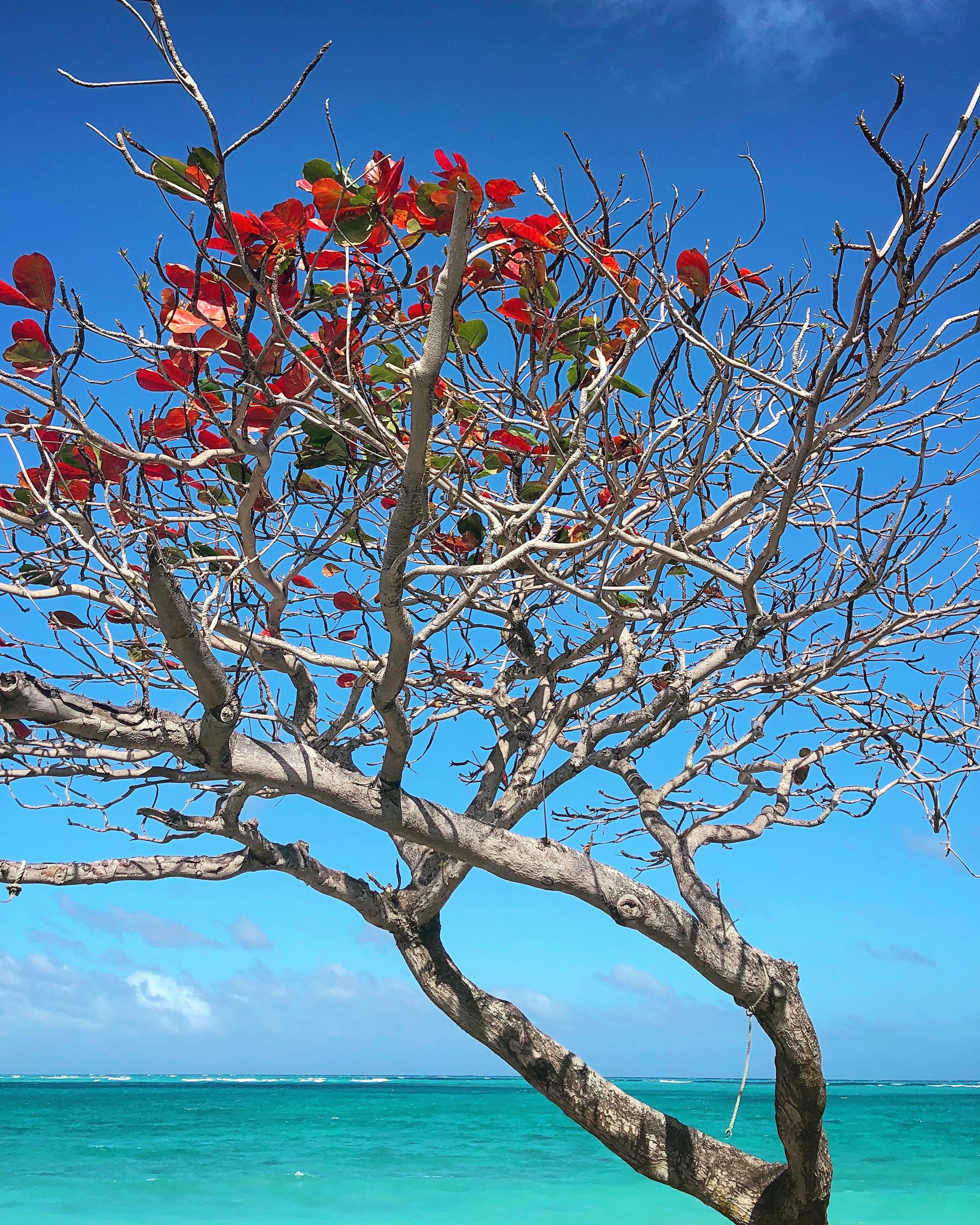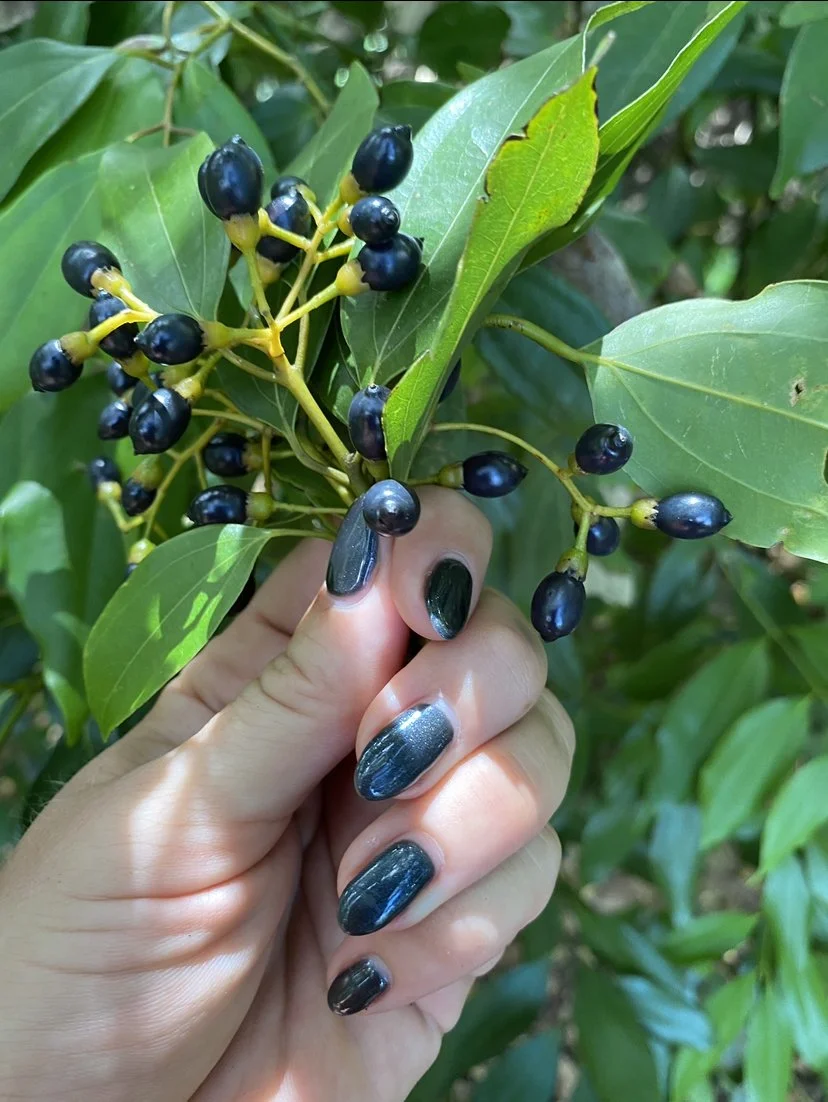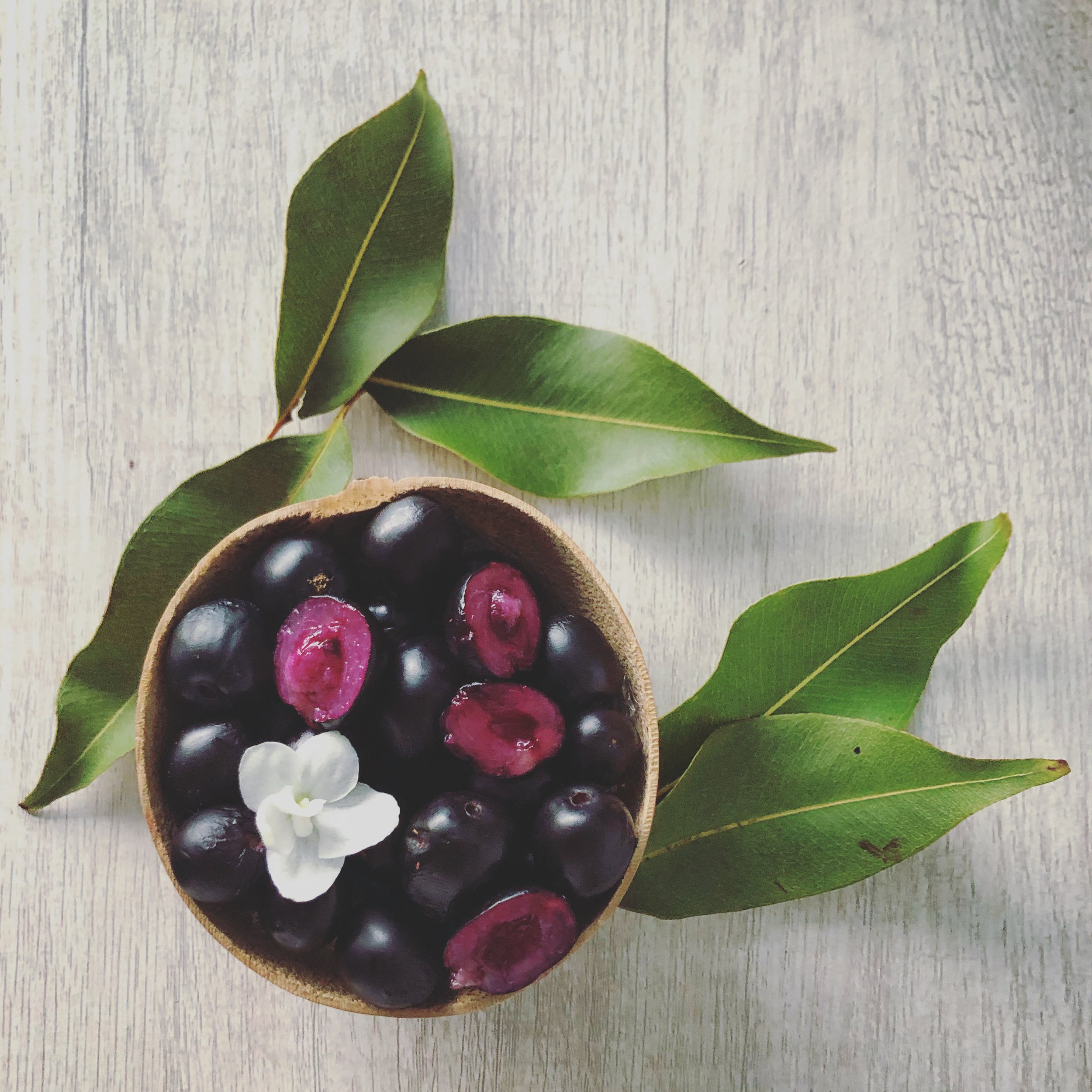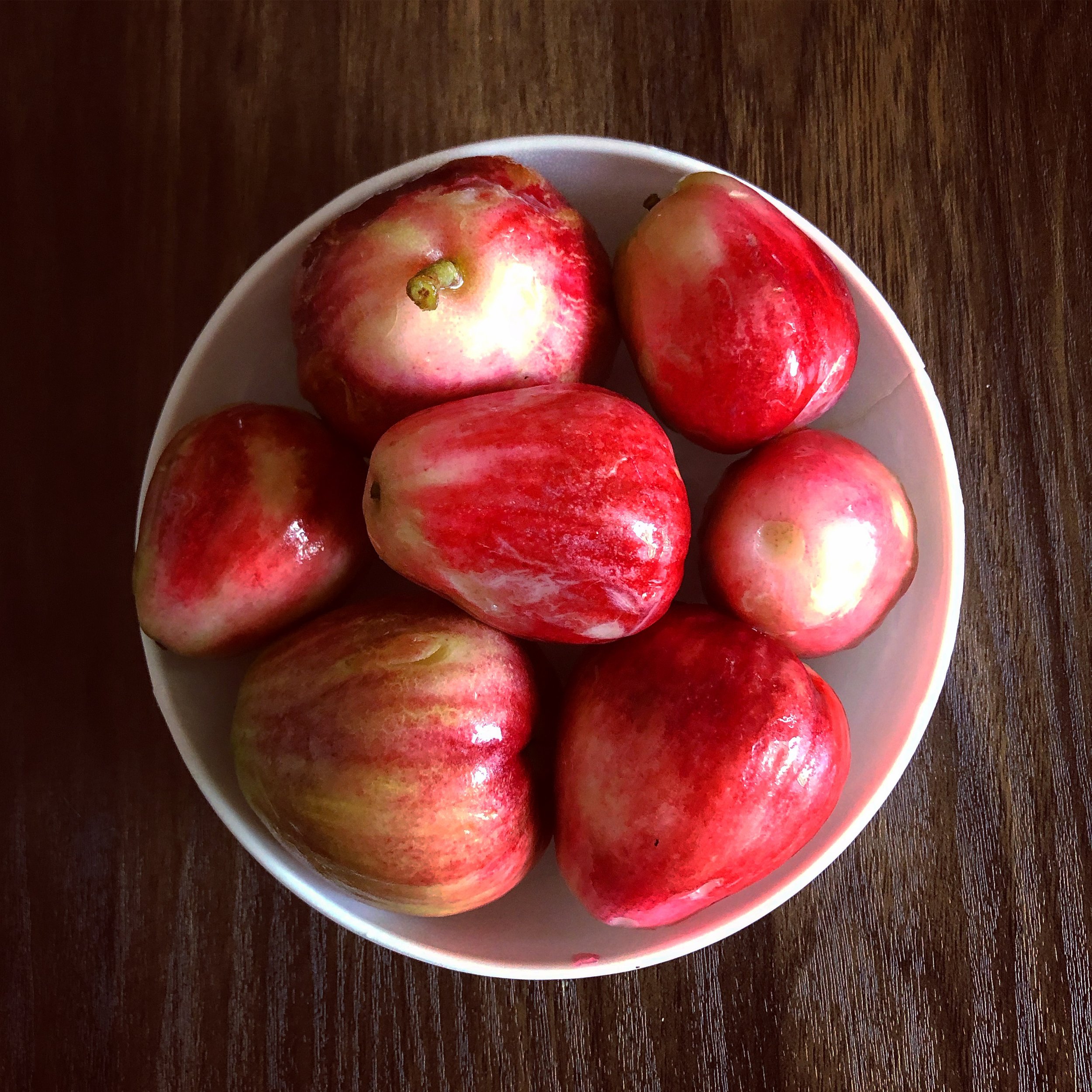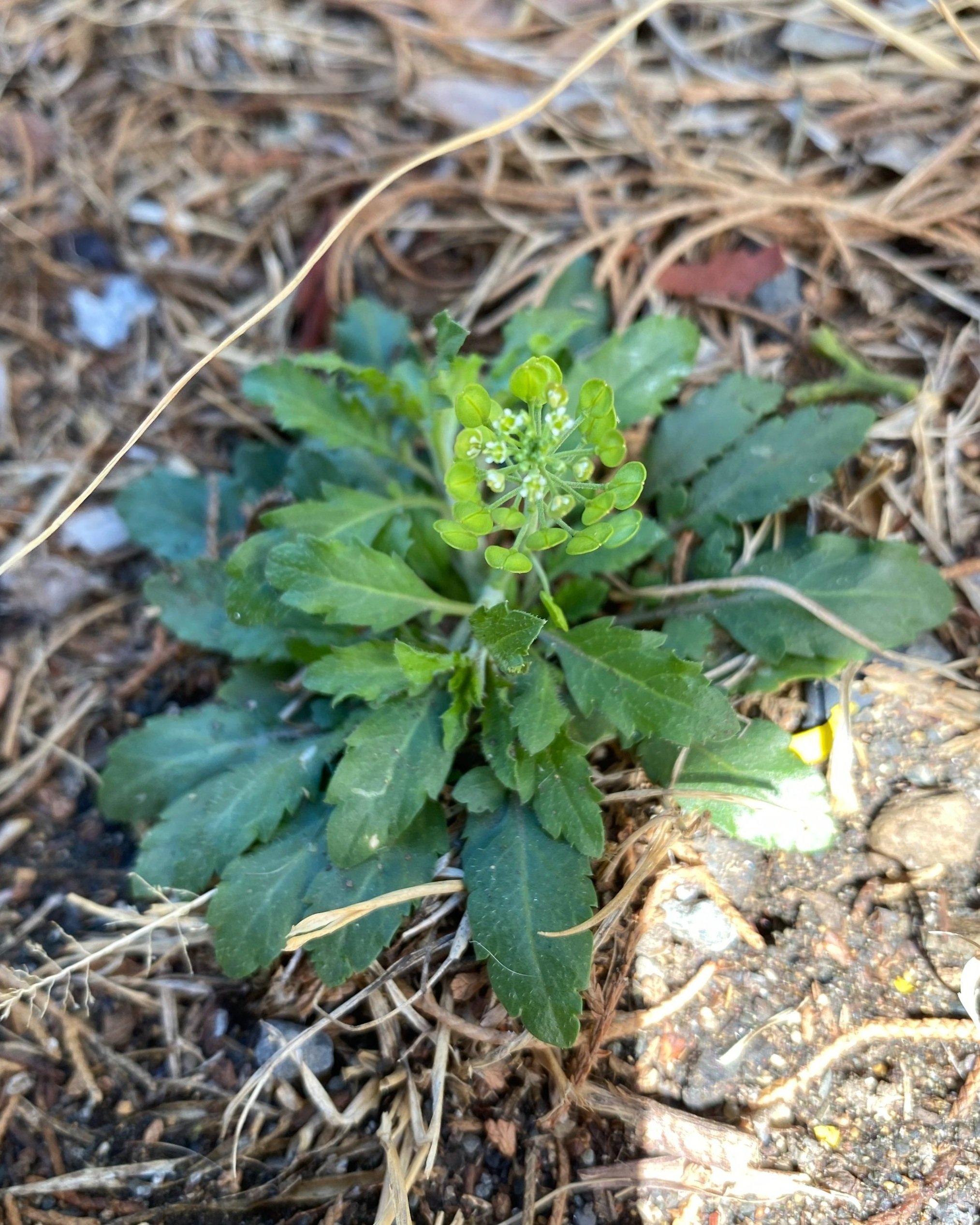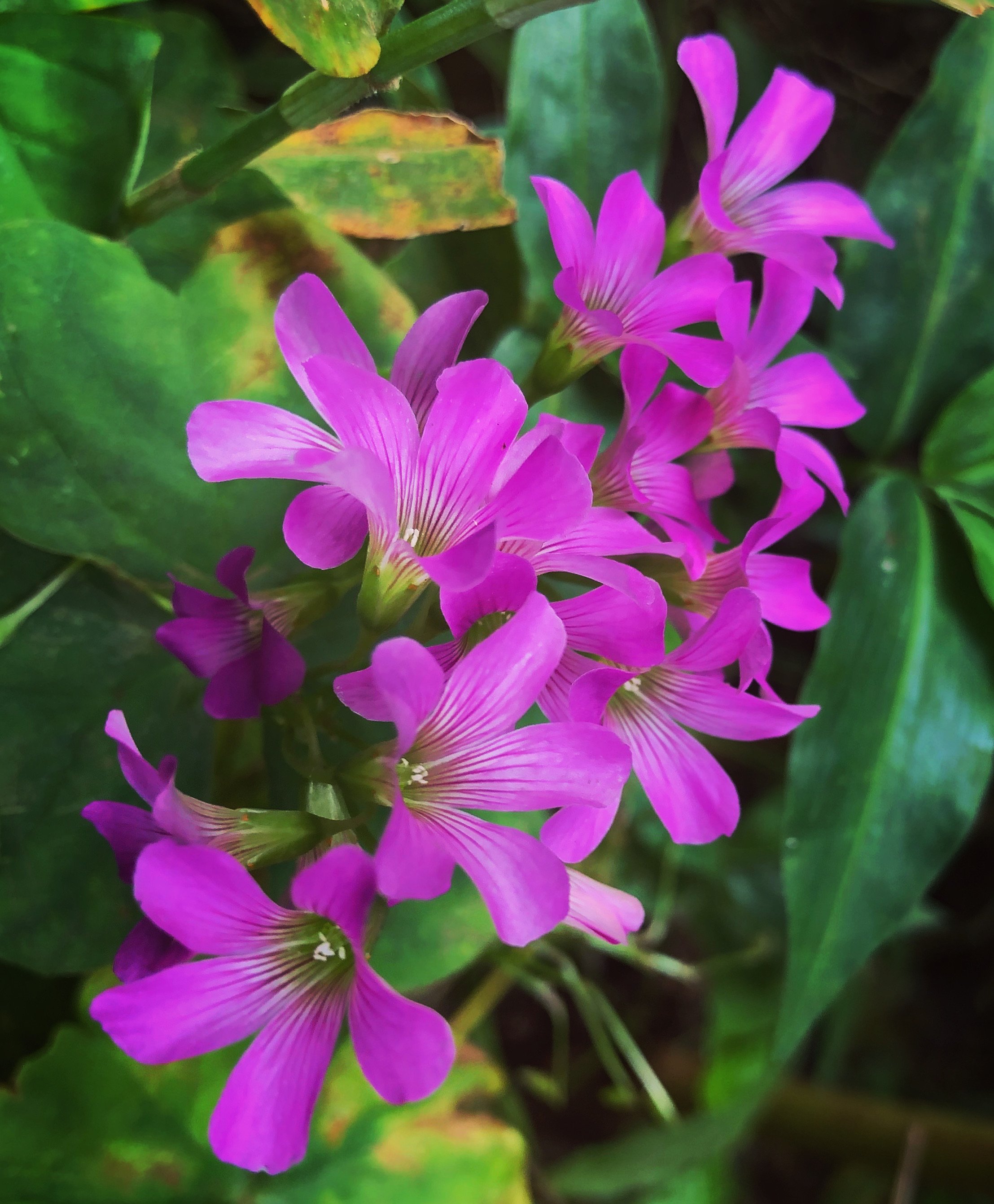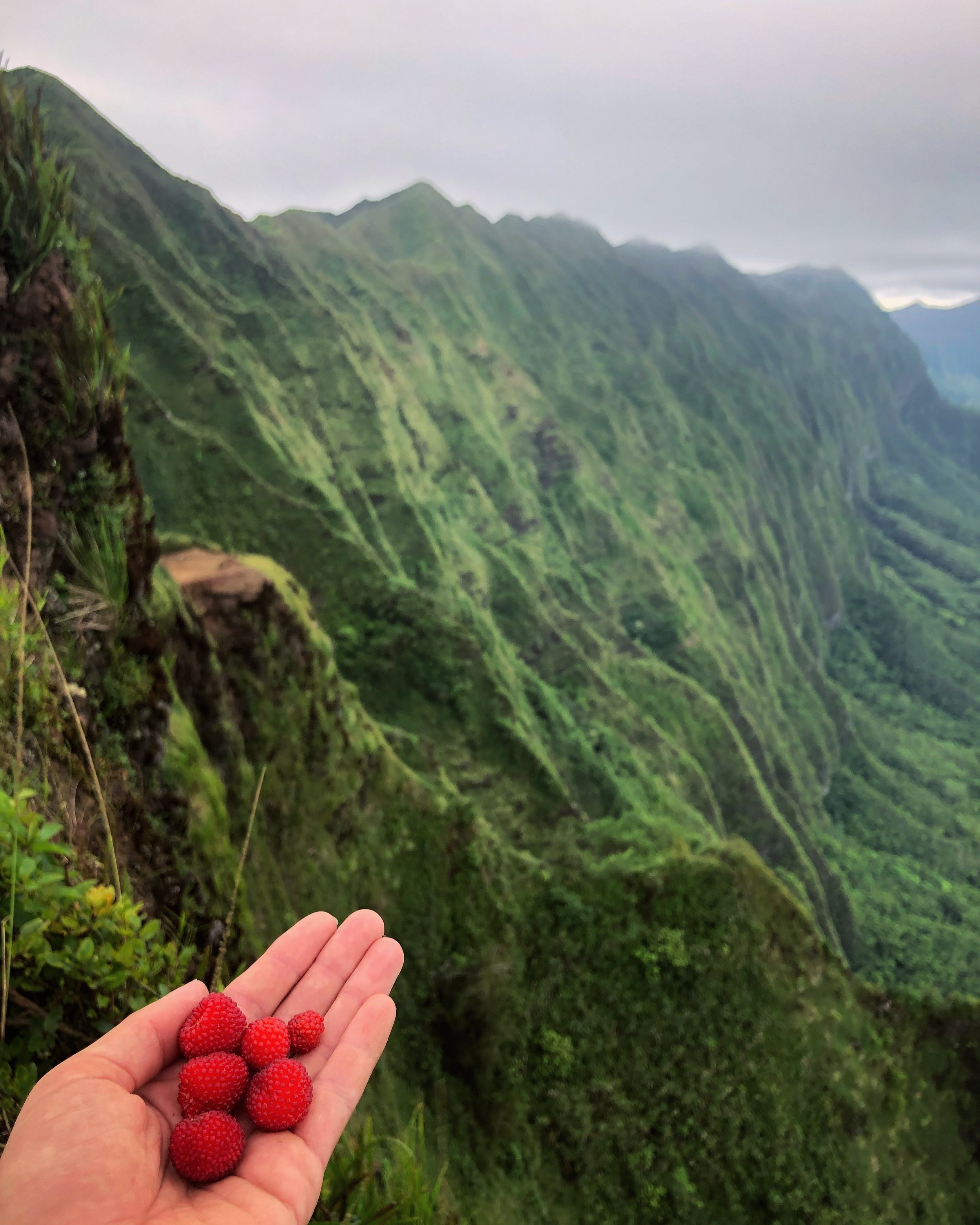
Wild Edible Plants
Learn about invasive wild foods found in Hawai’i.
This list is by no means inclusive of all the wild, edible plants available to you here in Hawai’i. I am learning new things every day, and doing my best to keep my website updated accordingly! Most of the plants listed are invasive, and therefore available for you to take as much as you can use. However, I have listed some abundant native Hawaiian plants and some canoe plants, which are considered naturalised and sometimes culturally sacred. I will list this information under “status” in the description… in these cases, it is best to either leave the plant alone or take only a small amount that you can use for yourself. In addition, while all the plants listed are edible, some of them need special preparation to remove certain toxins in order to render them safe for human consumption. This will also be listed in the description. In short, please read the fine print. Happy Foraging!
Avocado
Latin name Persea americana
Flavor: Creamy and vegetal
Status: Naturalized. Native to Mexico, avocado was brought to Hawai'i in the early 1800's by Don Francisco de Paula Marín, a confidant of King Kamehameha I.
Environment: Found in wet, mesic, low to medium elevations between August and November.
Edible uses: The creamy pulp around the seed is generally what is used for food source; however, the seeds are also somewhat edible. They contain a mild toxin, but if used in small quantities, is generally considered safe to consume. Use the fresh puree in a for a creamy cocktail (avocado goes great with lactic acid products such as coconut cream and almond milk!) or use the seeds to make an avocado pit orgeat.
Medicinal Uses: Contains high levels of healthy fats, fiber, potassium, and antioxidants.
Allspice
Latin Name Pimenta dioica, also known as Pimienta gorda in Spanish.
Flavor: Allspice is traditionally used as a baking spice and has a warm, woody, peppery flavor.
Status: Native to Jamaica, Allspice is a naturalized plant in Hawai'i, meaning that it is not indigeneous but has become established in the wild here on O'ahu.
Environment: It is typically found in more dry, arid areas, such as on the ridges behind Waimanalo and the on the west side of the island, as well as used for landscaping in urban areas of the island. While the leaves and bark are available year-round, the trees tend to blossom in the summer, while the berries ripen in Autumn.
Edible Uses: What is traditionally known as Allspice is made from the fruit(berries) of the plant; however, the bark, blossoms, and leaves can all be used as well. The bark peels easily from the tree, and can be used for smoke for cooking or for infusing spirits or cocktails. The blossoms can be used as garnish or for flavoring. I actually use the leaves most often (found in my Spiced Mountain Apple Syrup!) or used in mulled wine, soups, or teas. This species is dioecious, meaning it has separate male and female trees, so not every tree will have berries, even in the right season. When you find a fruiting female tree, mark its location so you can return to it!
Medicinal Uses: Allspice can be used as an anti-inflammatory to treat gastrointestinal ailments and as an oral anaesthetic by chewing on the leaves or berries (or a tea of either).
Aloe
Latin name Aloe vera, also known as Alo'e in Hawaiian.
Flavor: Cool, refreshing cucumber-like taste.
Status: There are over 500 species of Aloe, with Aloe vera var. barbadensis miller being primarily the subspecies used for various culinary and medicinal uses. The plant is native to N. Africa, but has become naturalized here in Hawai'i.
Environment: Aloe vera var. chinensis is the variety most often seen in Hawai'i, most often in drier, more arid habitats but can be found year-round.
Edible uses: The gel between the leaves is the part most often used, and can be made into a garnish, ice, liqueur, syrup, or whatever else you can think of!
Medicinal uses: I'm sure we've all heard of Aloe vera as the end-all, be-all for after sun treatment, but you probably didn't know that it also an antidiabetic and antiinflammatory! It’s also great for a variety of skin ailments. Be careful of the yellow part near the skin which is more used as a laxative.
Amaranth
Latin name Amaranthus spinosus, also known as Pakai Kuku in Hawaiian.
Flavor: Dry, vegetal leafy green, very similar to spinach.
Status: Invasive, sometimes considered a noxious weed.
Environment: Found in low elevations, often in urbanized areas.
Edible uses: Similar in texture and flavor as spinach, and can be used in similar ways. Although the leaves are most often used, the seeds can be cooked and consumed as a grain.
Medicinal uses: Amaranth is high in protein, beta carotene, potassium, calcium, and iron. Like its relative quinoa, it has all the essential amino acids, unlike regular grains in the grass family which need to be combined with beans to have complete amino acids if you’re vegetarian.
Avocado
Latin name Persea americana.
Flavor: Creamy and vegetal
Status: Naturalized. Native to Mexico, avocado was brought to Hawai'i in the early 1800's by Don Francisco de Paula Marín, a confidant of King Kamehameha I.
Environment: Found in wet, mesic, low to medium elevations between August and November.
Edible uses: The creamy pulp around the seed is generally what is used for food source; however, the seeds are also somewhat edible. They contain a mild toxin, but if used in small quantities, is generally considered safe to consume. Use the fresh puree in a for a creamy cocktail (avocado goes great with lactic acid products such as coconut cream and almond milk!) or use the seeds to make an avocado pit orgeat.
Edible uses: The creamy pulp around the seed is generally what is used for food source; however, the seeds are also somewhat edible. They contain a mild toxin, but if used in small quantities, is generally considered safe to consume. Use the fresh puree in a for a creamy cocktail (avocado goes great with lactic acid products such as coconut cream and almond milk!) or use the seeds to make an avocado pit orgeat.
Medicinal Uses: Contains high levels of healthy fats, fiber, potassium, and antioxidants.
Basil
Latin Name Ocimum gratissimum, also known as clove basil, cinnamon basil, wild basil, or African basil.
Flavor: Bright, vegetal, herbaceous. Produces a tingly, "numbing" sensation around the mouth.
Status: Naturalized; Native to Africa.
Environment: Can be found year-round, although the plant produces flowers between February and March. Found in drier, more arid conditions such as the East and West Sides of O'ahu.
Edible Uses: Edible leaves, seeds, and blossoms.
Medicinal Uses: Used to alleviate respiratory and gastrointestinal ailments; can also be used as an antibacterial.
Beach Almond
Latin Name Terminalia catappa.
Flavor: Nutty and earthy.
Status: Highly invasive; Native to Southeast Asia.
Environment: Found mostly around the coast, along the edges of most beaches. Produces fruit mostly during fall and winter seasons.
Edible Uses: Fruit (nuts) can be used to make an orgeat, just make sure you roast them first! However, the fruits are quite fibrous and therefore difficult to work with.
Medicinal Uses: Can be used as an anti-inflammatory and anti-diabetic; also high in antioxidants.
Beach Vitex (Pōhinahina)
Latin name Vitex Rotundifolia, also known as Pōhinahina in Hawaiian.
Flavor: Dry and herbaceous; very similar to sage.
Status: Native to Hawai'i; however, used in landscaping and therefore found in abundance so okay to take in moderation (for now).
Environment: Found mostly in coastal areas; and also some urban areas due to its popularity in landscaping.
Edible Uses: Edible flowers and leaves; used as an herb for flavoring.
Medicinal Uses: Used for respiratory and gastrointestinal ailments; also as a remedy for headache. An extract of the seeds has been found in lab studies to work against endometriosis as well.
Blue Marble Fruit
Latin name Elaeocarpus angustifolius.
Flavor: Edible but dry, dusty, astringent, sour, bitter. Not palatable raw.
Status: Naturalized; Native to Australia.
Environment: Found in low to medium elevations in jungle-like habitats. The trees grow very tall but fruit can be found on the ground in February through August.
Edible Uses: I've tried to manipulate this fruit in so many different ways, and all but one have failed: simple syrup. The sugar turns this fruit into something somewhat palatable (the syrup still has a tannic, musty, forest floor flavor [in a good way], but sadly doesn't celebrate the blue color of the fruit [but still comes out a beautiful soft dusty rose color!]). If you find a seed with more than the normal five sides, it might be quite valuable, especially if it has fourteen sides!
No known medicinal uses.
Bougainvillea
Latin name Bougainvillea glabra or Bougainvillea spectabilis, sometimes referred to as paper flower.
Flavor: Bland with a slight bitter taste and dry texture.
Status: Invasive; brought to Hawaii by Father Alexis John Augustine Bachelot in 1827; Native to South America and specifically Brazil.
Environment: Found year-round in dry, coastal areas up to 3,000 feet.
Edible Uses: Flower bracts (the brightly colored leaves) are edible and can be eaten fresh as a vegetable in salads, deep fried, and used for color in drinks. Can also be used as a garnish.
Medicinal uses: Used for antifertility purposes in some indigenous cultures. Also used as an antidiabetic, anti-inflammatory, detoxifier, and for fever and respiratory ailments.
Candlenut (Kukui)
Latin name Aleurites moluccans, known as Kukui in Hawaiian.
Flavor: *Must be roasted first, otherwise toxic* Nutty with a dry consistency yet buttery flavor.
Status: Non-native to Hawaii, but culturally significant. It is the state nut of O’ahu. One of many canoe plants brought to the islands by Polynesian settlers for its many uses. Thought to be native to Malaysia or Indonesia.
Environment: Found in low to medium elevations; fruits anytime between summer and winter.
Edible Uses: Once again, must be roasted before consuming. Only the nut meat is edible but once roasted and chopped can be used as a seasoning on salads and poke, but I like to make an orgeat (nut based syrup) from them.
Medicinal Uses: Used in pre-colonized Hawaii as a light source, as the oil can burn for up to 30 minutes and was hence used as a torch. The dried, hardened nuts are still often used in lei making, and the oil can be used as a moisturizer and anti-aging skin care treatment and also to ward off evil spirits when visiting heiau or other sacred sites. The sap from the branches and leaves can be used to treat dry skin conditions, such as cold sores and eczema, and the bark produces a reddish-brown dye that can be used to dye kapa cloth or to paint canoes or even in tattoos. The crushed leaves can be used to relieve arthritis or bruises. Consuming kukui nuts can also relieve constipation and boost the immune system with its high Vitamin E and C content. Anti-microbial and anti-inflammatory. Contains Omega-3 fatty acids and high protein, fiber, calcium, potassium, and iron.
Chinese Violet
Latin name Asystasia gangetica.
Flavor: Sweet and floral.
Status: Invasive; native to India and Africa.
Environment: Found year-round in lower elevations in drier or coastal areas.
Edible Uses: Both flowers and leaves are edible raw or cooked. Flowers range from white to dark purple and get sweeter the darker they are. Leaves are sweet and crisp on the outside with a slight slimy consistency similar to okra.
Medicinal Uses: Anti-bacterial, anti-inflammatory, detoxification, reduces fever. Used in Africa to relieve asthma.
Cinnamon
Latin name Cinnamomum burmannii, also known as Kinamona in Hawaiian.
Flavor: Warm and woody with a light spice.
Status: Invasive; Native to Sri Lanka. Brought to Hawai’i in the late 1800’s.
Environment: Found year-round in low to medium elevations. Especially prominent in Nu’uanu Valley and on Tantalus. Berries fruit in fall and winter seasons.
Edible Uses: What most of us are familiar with (cinnamon sticks and cinnamon powder) is made from dehydrating the inner wood shoots beneath the bark. However, the leaves and berries are edible as well as the bark. Toxic in large quantities due to coumarin and sometimes high levels of lead absorption from soil (not typically a concern with wild cinnamon).
Medicinal Uses: Anti-oxidant, anti-inflammatory, anti-diabetic, anti-neurodegenerative, and anti-bacterial.
Coconut
Latin name Cocos nucifera, also known as Niu in Hawaiian
Flavor: Nutty, salty, and sweet with a creamy, milky texture.
Status: Naturalized; native to Southeast Asia.
Environment: Fruits year-round but peaks June-October; Almost exclusively found in coastal areas.
Edible Uses: Edible flesh and milk/water inside the hard outer shell.
Medicinal Uses: Antioxidant and beneficial for cardiovascular health.
Coffee
Latin name Coffee arabica, also known as Kope in Hawaiian.
Flavor: Earthy, acidic, and bitter with a slightly sweet aftertaste.
Status: Naturalized; native to Ethiopia.
Environment: Fruits in fall to winter months and can be found in wet, mesic environments at low to medium elevations.
Edible Uses: Leaves, fruit, and seeds can be consumed; however, this plant is most noted for its seeds, which are what is known as “coffee beans” and are often dried, roasted, ground, and steeped into what we know as coffee. Leaves can be steeped into a caffeinated tea, as can the coffee “cherries,” or the pulp around the seeds.
Medicinal uses: Contains caffeine so can be used as a stimulant, as well as a diuretic, and is good for cardiovascular, muscular, and lymphatic health.
Coralberry
Latin name Ardesia elliptica, also known as inkberry or tag in its native Filipino. .
Flavor: Dry and astringent with tannic dark fruit flavors.
Status: Invasive; native to Indochina and India.
Environment: Found in medium elevations; berries ripen August through December.
Edible Uses: Berries and young leaves can be used.
Medicinal Uses: Anti-oxidant, anti-inflammatory, respiratory and gastrointestinal.
Cordia Family
Latin name Cordia subcordata, also known as Kou in Hawaiian, and Cordia sebestena, also known as the Geiger tree.
Flavor: Both are bland with a fibrous texture and previously used only as a sustanance food in times of famine.
Status: Cordia subcordata (Kou) was considered a naturalised canoe plant until very recently when evidence of Kou pre-dating Polynesian settler introduction was found on the island of Kauai, meaning it is now considered native to Hawai’i. However, Cordia sebestena (Geiger tree) is considered non-native and possibly invasive, though it is mostly used for landscaping purposes.
Environment: Dry, coastal areas or urban areas; blooms and fruits year-round.
Uses: Flowers and nuts. Leaves can be used for kapa dye, wood was traditionally used for carving bowls and cups, and flowers used to make lei. Nuts were consumed in times of famine. Both have respiratory and digestive health benefits.
Crotolaria Pallida
Latin name Crotolaria Pallida.
Flavor: Roasted, woody, and nutty flavor.
Status: Naturialized; native to tropical Africa.
Environment: Found in dry environments at low to medium elevations.
Edible Uses: Flowers can be eaten raw. Roots can be chewed and has an effect similar to that of beetlenut. Seeds can be roasted and steeped and has an effect similar to coffee.
Medicinal uses: Anti-inflammatory.
Dragonfruit
Several species of dragonfruit, including: Hylocerus undatus (pink skin with white flesh), Hylocerus costaricensis (red flesh), and Hylocerus megalanthus (yellow skin with white flesh). Often called by its Spanish name pitaya or pitahaya.
Flavor: Somewhat flavorless but fresh, juicy texture. The red variety is often used in cocktails or culinary art for its vibrant color.
Status: Non-native to Hawaii; first brought in 1830. Native to Southern Mexico and Central America, and possibly South America as well.
Environment: Found in dry, arid conditions at low-medium elevations. Fruits between July and October, although pollination can be difficult and therefore sparsely found in the wild.
Edible Uses: Fruit and flowers.
Medicinal Uses: Contains high amounts of fiber and antioxidants. Also known to prevent colon cancer and diabetes, reduce high blood pressure and high cholesterol levels.
False Cardamom
Latin name Alpinia zerumbet “variegata,” also known as shell ginger.
Flavor: Very similar to cardamom with piney, fruity, and almost menthol-like notes.
Status: Invasive; Native to Northeast Africa.
Environment: Found in wet, mesic areas in low to medium elevations. Flowers year-round.
Edible Uses: Edible seeds, leaves, and flowers (flowers only edible once they are open, revealing the yellow body with red throat and pollen is scraped or washed off).
Medicinal uses: Used to make tonic, and as a carminative, laxative, and purgative.
Fiddlewood
Latin name Citharexylum caudatum or Citharexylum spinosum.
Flavor: Sweet, musky, dark fruit flavors reminiscent of tobacco.
Status: Highly invasive; Native to Florida, Central America, and the Caribbean.
Environment: Found at low to medium-high elevations; fruits year-round but peaks in December-January. Often used for landscaping in urban Honolulu.
Edible Uses: Fruit. Be careful to spit out seeds (and dispose of them properly so as not to spread this invasive plant!) as seeds can cause nausea and vomiting in larger quantities.
Medicinal Uses: Used to cure respiratory ailments.
@kyndraforever
Fig
There are over 700 species of fig, over 200 of which are present in Hawai’i. The most common species found in the wild in Hawai’i are Creeping Fig (Ficus pumila), Moreton Bay Fig (Ficus macrophylla), Banyan (Ficus benghalensis), Strangler (Ficus aurea), Rustyleaf (Ficus rubiginosa), and Chinese Banyan (Ficus microcarpa).
Flavor: Although some varieties are sweet, most are bitter and astringent with an earthy flavor and dry texture.
Status: All varieties are either invasive or naturalised (all being non-native).
Environment: Most grow at low-medium elevations, often in wet, mesic forest environments but equally as often in coastal and urban areas.
Edible Uses: Depending on the species, fruits and leaves tend to be edible but are sometimes not palatable. The common fig (Ficus carina) can sometimes be found in Urban areas and while the fruit is edible (and tasty!), a lesser known use is that simple syrup can be made from the leaves.
Medicinal uses vary depending on species.
Also referred to as ‘Awapuhi in Hawaiian.
There are several subspecies of ginger, many of which are present in Hawaii. Subspecies include:
•Hedychium coronarium (known as ‘awapuhi ke’oke’o in Hawaiian and white ginger in English): Edible roots, flowers, and leaves. Flavor is delicate, floral, and has a strong perfume.
•Hedychium flavascens (known as ‘awapuhi melemele in Hawaiian and yellow ginger in English): Edible roots, flowers, and leaves. Flavor is floral, has a strong perfume, and a slightly stronger spicy ginger flavor than that of white ginger.
Hedychium gardnerianum (known as ‘awapuhi kāhili in Hawaiian): Edible roots, flowers, and leaves. Flavor is floral with an even spicier, rounder, ginger flavor than that of yellow ginger.
Zingeber officinale (also known as ‘awapuhi pākē in Hawaiian and common- or culinary- ginger in English): Edible roots and leaves. Flavor is sharp and spicy.
Zingeber zerumbet (also known as ‘awapuhi kuahiwi in Hawaiian and shampoo ginger in English): Edible rhizomes. Indigenous Hawaiians used the secretions from this ginger for soap and shampoo.
Status: All types of ginger are non-native, and most are considered invasive. Most are native to Indochina and were brought to Hawai’i by early Polynesians around 5000BP (3050BC) for their many uses.
Environment: Most species grow at low-medium elevations in wet, mesic rainforests. Ginger flowers during multiple seasons (although I have typically found it most between August and October) but leaves and roots are available year-round.
Medicinal Uses: Although medicinal uses vary by sub-species, most contain the following: inhibiting cancer cell growth, increased appetite, anti-seizure, anti-fever, skin irritant relief, relief of respiratory ailments, anti-inflammatory, weight loss, anti-malarial, and many others.
Guava
Latin name Psidium guajava, known as Ku’awa in Hawaiian.
Flavor: Sweet, tart, with a floral perfume.
Status: Classified as invasive; Native to the Caribbean, as well as Central and South America.
Environment: Low to medium elevations in rainforest environments. Fruits between August and September, though bark is available year-round.
Edible Uses: Fruit, leaves, and bark, which can be burned in order to induce flavour through smoke.
Medicinal Uses: Fruit is used to relieve high blood pressure. Leaves and seeds can be used as a laxative, while just the leaves can be used to treat diabetes, wounds and skin conditions, as well as for pain relief.
Haole Koa
Latin name Leucaena leucocephala, also known as River Tamarind in English or guaje in Spanish and Nahuatl.
Flavor: Young seeds have a sharp, garlic-like flavor.
Status: Extremely invasive to Hawai’i; native to Southern Mexico and Northern Central America.
Environment: This extremely invasive plant thrives in many environments on O’ahu, including coastal to rainforest, low to mid-high elevations, and dry to wet environments.
Edible uses: Very young tender seed pods before the seeds are visible can be fried and made into “haole fries.” The young, green seeds inside the pods are eaten for their garlic-like flavor. The seeds are coated in a toxic protein called mimosene, which can be removed by soaking the seeds in water and boiling. Flowers are edible but the texture makes them unpleasant; however, they can be used to make syrups, hydrosols, and capers when picked green, soaked, boiled, and pickled. Do not consume more than 10% of your diet in haole koa, and avoid it if you are pregnant or trying to get pregnant.
Medicinal uses: Seeds contain protein and can ease gastrointestinal pain, cure and prevent diabetes, prevent cancer, and can be used to facilitate abortion and provide contraception.
Hong Kong Orchid
Latin name Bauhinia blakeana.
Flavor: Slight floral perfume but not a lot of flavor.
Status: Non-native to Hawai’i; Native to China.
Environment: Often used for landscaping in Urban Honolulu.
Flowers year-round but peaks from September to January.
Edible Uses: Edible flowers can be used as a vegetable, a fresh garnish, or candied/dehydrated. Very young seed pods before they become woody can be baked or fried and eaten like fries.
Medicinal uses: Used to treat skin conditions, respiratory ailments, and used as an anti-inflammatory and anti-oxidant.
Hibiscus
Also known as Koki’o in Hawaiian.
There are over 300 subspecies of Hibiscus, many of which are present in Hawai’i. The seven species native to Hawai’i (and some of the only fragrant Hibiscus in the world), include:
Hibiscus arnottianus (known as Koki’o Ke’oke’o in Hawaiian, which means “white like the shine of silver”): Endemic to Hawai’i, edible and one of the most fragrant types of hibiscus.
Hibiscus brackenridgei (known as ma’o hau hele in Hawaiian): The state flower of Hawai’i; yellow color with a red center.
Hibiscus clayi: Red colored hibiscus.
Hibiscus furcellatus (known as ‘akiohala, ‘akiahala, ‘hau hele, ‘or hau hele wai in Hawaiian): pink colored hibiscus.
Hibiscus kokio: Reddish-orange colored hibiscus. Extremely rare/endagered.
Hibiscus tillaceus (known as Hau in Hawaiian): Extremely common coastal plant with flowers that bloom yellow earlier in the day and turn reddish-orange later in the day (pictured left).
Hibiscus waimeae (known as kokio kea in Hawaiian): white colored hibiscus endemic to Hawaii.
Flavor: Hibiscus does not contain much flavor but the color can often be translated to food or cocktails or used as a garnish.
Status: The seven listed above are native to Hawaii and therefore should be left alone if seen in the wild, with the exception of Hau, which is fairly abundant but should still be foraged according to need. Other types of Hibiscus can be purchased or found in the wild are non-native.
Environment: Non-native types of hibiscus used for landscaping in Urban areas; Hau found along the coast of O’ahu.
Edible Uses: Most types of hibiscus are edible and although most don’t have a lot of flavor, some can impart color onto food or cocktails. They also make for a beautiful if not extravagant garnish.
Medicinal Uses: Can be used to lower body temperature, treat heart and nerve diseases, cancer, liver disease, respiratory ailments, and as a diuretic.
Ixora
Latin name Ixora coccinea, also known as West Indian Jasmine.
Flavor: Rich floral fragrance, with a slightly bitter aftertaste.
Status: Naturalized in Hawai’i; Native to India and Sri Lanka.
Environment: Used for landscaping purposes in urban and coastal areas. Flowers year-round.
Edible Uses: Edible flowers can be used as a garnish or for flavoring.
Medicinal Uses: Posesses antioxidative and antibacterial qualities; can be used to treat fever, headache, and diarrhea; also can be used as a sedative.
Java Plum
Latin name Syzygium cumini
Flavor: Astringent, dry, sweet, and tart.
Status: Extremely invasive in Hawai’i; Native to India and Southeast Asia.
Environment: Can be found in low to medium elevations, anywhere from wet rainforest climates to dry coastal areas. Fruits between August and February, with peak season in December and January.
Edible uses: Mostly known for the edible fruits; however, leaves can be used for flavoring or medicinal purposes.
Medicinal uses: Used as a diuretic, to treat gastrointestinal ailments, and as an anti-diabetic.
Kiawe
Latin name Prosopis pallida, also known as Mesquite in English.
Flavor: Dry, sweet, earthy.
Status: Invasive in Hawai’i; Native to South America.
Environment: Grows in dry, coastal areas. Fruits July through November.
Edible Uses: Wood can be used for cooking, but the yellow fruit (beans) that fall from the tree in summer and autumn have surprising nutritional benefits and can be used in a variety of ways. Beans can be used to make tea or crushed and dried to make a naturally gluten free flour. Beans contain 45% fructose, 15% protein, and 30% insoluable fiber, making it a safe alternative for diabetics.
Medicinal benefits: Anti-diabetic. Also contains calcium, iron, potassium, magnesium, and zinc.
Macadamia Nut
Latin names Macadamia tetraphylla and Macadamia integrifolia– there are two main species of Macadamia nut, followed by over 50 hybrids, most of which are present in Hawai’i. Macadamia tetraphylla is the most prevalent species found in the wild on O’ahu.
Flavor: Buttery, sweet, and salty with an oily texture.
Status: Introduced to Hawai’i; Native to Australia. Brought to Hawai’i in 1881.
Environment: Found at low to medium elevations in moderately wet forests.
Edible Uses: Mostly known for the nut meat; however, flowers can be used to infuse liquids and leaves used for flavoring.
Medicinal Uses: High in healthy fats and antioxidants. Potential benefits include weight loss, improved gut health, as well as diabetes and heart disease prevention.
Mango
Latin name Mangifera indica.
There are over 500 varieties of mango in the world, 63 of which are present in Hawai’i. Of these, the most common are Rapoza, Hayden, and Pirie.
Flavor: Sweet and creamy with a slight acidity.
Status: Invasive to Hawai’i; Native to both Southeast Asia and India. Brought to Hawai’i in 1824 by Captain John Meek from Manila.
Environment: Mango is widely cultivated in Hawai’i, but can be found anywhere from farms to private yards to the wild. Mango trees grow very large and are mostly found at low elevations on farmland or in residential areas. Fruits between May and September with peak season occurring in July.
Edible Uses: Most known for the edible fruit, but flowers and leaves can also be used for flavoring. Be careful not to eat mangoes out of the skin directly since the skin contains the toxic urushiol oil that can cause rashes and allergies like in the related poison ivy and poison oak. Always eat mangoes with a spoon.
Medicinal Uses: High in Vitamin C and antioxidants; used to support immune system, digestive, and heart health. Also great for hair and skin!
Mountain Apple
Latin name Syzygium malaccense, also known as Ohi’a ‘ai in Hawaiian.
Flavor: Sweet with almost floral aromatics, with a mealy consistency.
Status: Naturalized in Hawai’i; Native to Malaysia.
Environment: Thrives in low elevations in wet climates, and fruits between May and August.
Edible Uses: Mostly known for the edible fruits, but flowers and leaves can be used for flavoring as well.
Medicinal Uses: Used to curb blood sugar levels, as well as digestion and detoxification. Useful in treating anemia and preventing cancer.
Natal Plum
Latin name Carissa macrocarpa. Also known as nom nom in its Native South African dialect.
Flavor: Sour, tart, and sweet red fruit.
Status: Cultivated and used for landscaping in Hawai’i. Native to South Africa.
Environment: Found at low elevations, primarily in urban or coastal settings.
Edible Uses: All parts of the plant are toxic except for the fruits that will turn bright red when ripe and ready to eat.
Medicinal Uses: Promotes a healthy immune system.
Noni
Latin name Morinda citrifolia.
Flavor: Unpleasant odor and taste that has been described as similar to vomit, rotten cheese, or turpentine.
Status: Naturalized in Hawai’i; native to Southeast Asia and Northern Australia. Brought to Hawai’i as a canoe plant by early Polynesian settlers.
Environment: Found in low to medium elevations in mesic rainforests and cultivated for personal and commercial use.
Edible Uses: Edible fruit and leaves.
Medicinal Uses: Used to treat diabetes, heart disease, and high blood pressure, weak immune system, skin cancers and skin irritations. A lot of people find the fruit itself to have a foul flavour and mouthfeel, but the nutritional and medicinal benefits can still be enjoyed by steeping the leaves in water to make a tea.
Papaya
Latin name Carica papaya; also known as pāpā’ia, mīkana, or hē’i in Hawaiian.
Flavor: Sweet and a little “soapy” with a thick, creamy, fleshy consistency. Has a floral melon-like aroma.
Status: Native to the tropics of the Americas; naturalized and cultivated in Hawai’i.
Environment: Found cultivated in low to medium elevations in urbran, coastal, and farmed environments. Season is nearly year-round but peaks in April-June and Oct-Dec.
Edible Uses: Mostly known for the edible fruits, but seeds, leaves, and flowers have edible uses if boiled as well.
Medicinal Uses: High in antioxidants and great for dermatological health.
There are over 400 species of Passiflora (also known as passion fruit), seven of which are commonly found in the wild in Hawai’i:
Passiflora edulis (also known as liliko’i in Hawaiian): white and purple flowers (refer to picture on the right) that produce a fruit with yellow skin in the flavicarpa variety and purple skin in the edulis variety, both with yellow pulp with black seeds. This popular tropical fruit has a sweet yet tart flavor.
Passiflora subpetalata (also known as white passionflower): all white flower with bluish green fruit. This variety of passiflora contains cyanic acid, which is toxic.
Passiflora suberosa (also known as Corkystem Passionflower): Small off-white or light green flower with small dark purple fruit. Not very flavorful.
Passiflora foetida (also known as carnivorous passionflower because it can trap insects and absorb the nutrients from the decayed bodies): Small white and purple flowers with a small pale yellow fruit. Contains cyanic acid but the inner flesh is edible. Creamy, tart and sweet flavor.
Passiflora vitifolia (also known as scarlet flame): Bright red flower with oblong fruits that are green with white stripes that resemble watermelon. Sour flavor.
Passiflora laurifolia (also known as water lemon): Light green and purple striped flowers that hang upside down. Fruit is orange with low acidity and sweet flavor.
Passiflora quadrangularis (also known as giant granadilla): beautiful purple striped flowers that hang upside down. Fruit is large like a papaya and stays mostly greenish yellow when ripe with very low acid flavor.
Passiflora iigularis (also known as granadilla): Light green and purple striped flowers that hang upside down. Fruit is yellow with low acidity.
Passiflora tarminiana (also known as banana poka in Spanish): Pink flowers that hang upside down with oblong yellow fruit. Tart and somewhat bitter flavor reminiscent of banana.
Status: Invasive to Hawai’i; Native to North America, Southeast Asia, and Oceania.
Environment: Found in low to medium elevations. Most are found wild but lilikoi (passiflora edulis) is widely cultivated throughout Hawai’i.
Medicinal Uses: High in Vitamin C, Vitamin A, Potassium, Antioxidants, Fiber, and can be used as an anti-diabetic, to lower blood pressure, and to reduce anxiety. Leaves should only be used after drying as they all contain toxic cyanogenic glycosides, but those are driven off during drying.
Peppergrass
Latin name Lepidium virginicum.
Flavor: Strong black pepper/mustard spice.
Status: Native to North America; Naturalized in Hawai’i.
Environment: Found at low elevations in coastal, rural, or urban settings.
Edible Uses: Most of the plant is edible but mostly known for the leaves and seed pods, which both contain the strong pepper flavor.
Medicinal Uses: High in protein, iron, and vitamins A & C.
Pomelo
Latin name Citrus maxima; also known as Jabong, Shaddock, or Pomplemousse.
Flavor: Sweet and tart with a slight floral scent; Genetic ancestor to grapefruit.
Status: Cultivated in Hawai’i; Native to Southeast Asia, specifically Malaysia.
Environment: Cultivated in urban settings in low elevations.
Edible Uses: Mostly known for the edible fruits, but flowers and leaves can be used for flavoring or to make a tea.
Medicinal Uses: High in Vitamin C, antioxidants, and fiber, and can be used as an antibacterial and antifungal. [Be careful not to consume if you are prescribed or using some anti-hypertensives, some anti-coagulants, some anticancer agents, some anti-infective agents, some statins, and some immunosuppressants as it can change the uptake of those particular drugs.]
Pōpolo Berry
Latin name Solanum americanum; commonly known as glossy nightshade..
Flavor: Sweet with flavors similar to tomato and dark plum.
Status: Possibly native to Hawai’i, but could be considered a canoe plant. There are four species of Solanum that are Native to Hawai’i and one species that has been introduced that is toxic. Therefore, it is best to only eat these when found in abundance but also if you’re quite sure of the subclassification.
Environment: Found in low to medium elevations from coastal climates to urban areas.
Edible Uses: Mostly known for the edible fruits but can also be used as a dye.
Medicinal Uses: Used to treat respiratory conditions, muscle soreness and fatigue, and arthritis.
Prickly Pear
Latin name Opuntia ficus-indica; also known as Panini in Hawaiian. In Spanish, the fruit is referred to as tuna and the leaves/pads are referred to as nopales.
Flavor: Sweet, fruity, and fragrant. Leaves are vegetal and slimy.
Status: Native to Mexico; Naturalized in Hawai’i.
Environment: Found in dry, arid conditions.
Edible Uses: Mostly known for the edible fruits, but leaves are edible as well, though a bit mucilaginous (like okra).
Medicinal Uses: Used as an antioxidant and anti-inflammatory. Pads can be used to treat diabetes.
Purslane
Several varieties: Latin names Portulaca oleracea, Portulaca lutea, and Portulaca villosa. Known as ‘ākulikuli kula in Hawaiian (see below for Sesuvium portulacastrum or sea purslane).
Flavor: Crunch, crisp, and slightly slimy on the inside.
Status: Portulaca oleracea is naturalized in Hawai’i; Portulaca lutea and villosa are native to Hawai’i.
Environment: Found in low to medium elevations in dry coastal or urban environments year-round.
Edible Uses: The entire plant is identified as an herb and all parts are edible.
Medicinal Uses: Can be used as a purgative, emollient, muscle relaxant, anti-inflammatory, diuretic treatment, and to stabilize blood sugar and insulin levels.
Screwpine
Latin name Pandanus tectorius; also known as Hala in Hawaiian.
Flavor: Light and refreshing fruit flavor reminiscent of watermelon.
Status: Native to Hawai’i.
Environment: Found year-round but peaks in September. Mostly coastal and found in low elevations.
Edible Uses: Fruit is edible raw or cooked.
Medicinal Uses: Used to promote cardiovascular health and for digestive and diuretic properties.
Latin name Psidium Cattleianum, also known as Waiawī in Hawaiian. Three subcategories: var. cattleyanum (red fruit), var. lucidum (yellow “lemon guava,” which is round), and var. littorale (also yellow “lemon guava,” which is more oval-shaped).
Flavor: Sweet and tart with a mealy and seedy texture.
Status: Native to S. America; Highly invasive in the Hawaiian Islands.
Environment: Grows in low to medium elevations all around the island, with peak fruiting season occurring March through November.
Edible uses: Mostly known for the edible fruit, but leaves can be used for flavor or for medicinal properties, and bark can be used for cooking or smoking.
Medicinal uses: Strawberry guava contains polyphenols, which are micronutrients believed to protect against heart disease, diabetes, and cancer. Also high in antioxidants. A tea made from the leaves can also be used to treat diarrhea.
Sea Grape
Latin name Coccoloba uvifera.
Flavor: Sweet and tannic like red wine with a distinct salty flavor.
Status: Native to Florida and the tropical Americas; introduced to Hawai’i.
Environment: Found year round in coastal environments.
Edible Uses: Known for its edible fruit.
Medicinal Uses: Promotes a healthy gastrointestinal system and helps to aid in digestion.
Sea Purslane
Latin name Sesuvium portulacastrum. Known as ʻĀkulikuli in Hawaiian.
Flavor: Salty sea vegetable with a crunchy texture.
Status: Native to Hawai’i.
Environment: Found year-round in coastal environments by the sea.
Edible Uses: Edible leaves, flowers, and stems.
Medicinal Uses: Used as an anti-bacterial, anti-fungal, anti-oxidant, and anti-convulsant.
Snow Mushroom
Latin name Tremella fuciformis.
Flavor: Bland flavor with a gelatinous and simultaneously crunchy texture.
Status: Native to tropical and sub-tropical regions throughout the world.
Environment: Found year-round in wet rainforests on decaying broadleaf trees.
Edible Uses: Edible fungus.
Medicinal Uses: Can hold thousands of tons its weight in water, making it one of the best natural ingredients for anti-aging and skin elasticity.
Soapbush
Latin name Miconia crenata, also known as Koster’s curse.
Flavor: Sweet dark fruit flavor reminiscent of blueberries with a seedy texture like strawberry.
Status: Native to the tropical Americas; Invasive to Hawai’i.
Environment: Found year round in low to medium elevations in both mesic and wet rainforest environments.
Edible Uses: Known for its edible fruit.
Medicinal Uses: Acts as an antimicrobial, antioxidant, and heptaprotective. Leaves also produce copious lather when rubbed with water, giving it its common name soap bush.
Surinam Cherry
Latin name Eugenia uniflora.
Flavor: Savory, sweet, sour, and slightly bitter.
Status: Native to Surinam, Brazil, and Guyana; Invasive to Hawai’i.
Environment: Found in low to medium elevations with its fruiting season occuring May-July.
Edible Uses: Known for its edible fruits.
Medicinal Uses: Used to treat high blood pressure, heartburn, as well as gastro-intestinal and respiratory ailments.
Tamarind
Latin name Tamarindus indica, also known as Wī’awa’awa in Hawaiian.
Flavor: Some subspecies are sweeter than others, but most have a sweet-sour, tangy and tart pulp.
Status: Native to tropical Africa; Naturalized and cultivated in Hawai’i.
Environment: Found at lower elevations in somewhat drier climates, with its peak fruiting season February-April.
Edible Uses: Edible fruit, leaves, and flowers.
Medicinal Uses: Used to treat gastrointestinal and digestive ailments.
Taro
Latin name Colocasia esculenta (though there are over 150 species cultivated for sustenance in Hawai’i), also known as Kalo in Hawaiian.
Flavor: Used to make the traditional Hawaiian sustenance food known as poi, which has a sweet, earthy, and slightly nutty taste; leaves also used for cooking.
Status: Native to India; Non-native in Hawai’i but is very culturally significant, as it was one of the first canoe plants brought by early Polynesian settlers and is mentioned in the Kumolipo, or Hawaiian creation chant.
Environment: Found in low elevations and flourishes in wet environments. year-round.
Edible Uses: Roots are used to make the traditional Hawaiian sustenance food known as poi, leaves also used in cooking. Must be cooked for an hour or longer in order to neutralise protease enzymes that prickle the throat.
Medicinal Uses: Serves as an anti-oxidant.
Tī Plant
Latin name Cordyline fruticosa, also known as Kī in Hawaiian.
Flavor: Leaves have a grassy, vegetal flavor.
Status: Native to Southeast Asia and Papua New Guinea; Non-native to Hawai’i but a culturally significant canoe plant.
Environment: Found in low to medium elevations in a variety of climates. Used a lot in landscaping but frequently found in the wild as well.
Edible Uses: Leaves used in cooking and roots can be fermented and distilled to make the traditional Hawaiian alcoholic spirit known as Okolehao.
Medicinal Uses: Used as a decongestant.
Velvet Apple
Latin name Diospyros blancoi or Diospyros discolor, also known as mabolo, velvet apple, or butter apple.
Flavor: Frangrant mixture of peach, pear, and apple, with funky, cheesy undertones.
Status: Native to the Phillipines; Naturalized and cultivated in Hawai’i.
Environment: Found at low to medium elevations in summer months.
Edible Uses: Edible fruit.
Medicinal Uses: Used as an anti-inflammatory and analgesic.
Vervain
Latin names Stachytarpheta jamaicensis, Stachytarpheta cayennensis, and Stachytarpheta urticifolia, and Stachytarpheta australis, also known as jamaican vervain.
Flavor: Has a very distinct umami flavor characteristic of mushrooms.
Status: Native to North, South, and Central Americas. Naturalized in Hawai’i.
Environment: Found in low elevations to medium elevations year-round; known to attract butterflies.
Edible Uses: Edible flowers.
Medicinal Uses: Promotes circulatory, respiratory, and gastrointestinal health. Leaves can be steeped into a tea that can calm anxiety.
Wood Sorrel
Latin name Oxalis corniculata (‘ihi ‘ai in Hawaiian meaning “edible ‘ihi [‘ihi is a native plant that has no relation to Wood Sorrel]”) and Oxalis debilis (‘ihi pehu in Hawaiian- meaning swollen ‘ihi).
Flavor: Crisp, refreshing, acidic lemon-like flavor.
Status: Native to North America and Eurasia; Invasive in Hawai’i.
Environment: Found year-round in low elevations in urban and/or mesic climates.
Edible Uses: Both leaves and flowers are edible and retain the same flavor.
Medicinal Uses: Used as an anti-oxidant and to treat cardiovascular and respiratory ailments, as well as neurodegenerative disorders. *Consuming too much oxalis at once can cause kidney stones and interfere with calcium absorption in large amounts due to large amounts of oxalic acid.
West Indian Raspberry
Latin name Rubus rosifolius, also known as ‘ōla’a in Hawaiian.
Flavor: Like raspberry but drier and less flavorful.
Status: Native to Asia and Australia; Naturalized in Hawai’i. .
Environment: Found at medium to high elevations year round.
Edible Uses: Edible fruit.
Medicinal Uses: Used to promote gastrointestinal health.
Yerba Mate
Latin name Ilex paraguariensis.
Flavor: Earthy, vegetal flavor.
Status: Native to Central and South Americas. Naturalized in Hawai’i.
Environment: Found in low to medium elevations year-round in Hawaii.
Edible Uses: Edible leaves.
Medicinal Uses: Contains caffeine and high in antioxidants. Used as an anti-diabetic and anti-microbial and promotes cardiovascular and digestive health.
\







